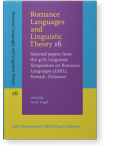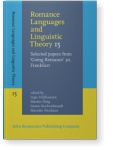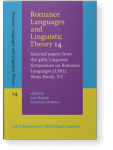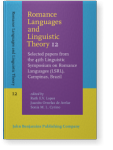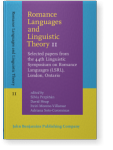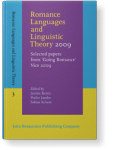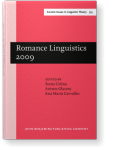Isabelle Charnavel
List of John Benjamins publications for which Isabelle Charnavel plays a role.
2020 French causal puisque-clauses in the light of (not)-at-issueness Romance Languages and Linguistic Theory 16: Selected papers from the 47th Linguistic Symposium on Romance Languages (LSRL), Newark, Delaware, Vogel, Irene (ed.), pp. 49–64 | Chapter
This paper examines the discourse status of French causal clauses introduced by puisque ‘since’. Puisque-clauses are associated with two implications: the relation expressed by puisque and the content of their clause. Several diagnostics show that neither implication is at-issue and that the two… read more
2019 Chapter 5. Point of view on causal clauses: The case of French parce que and
puisque Romance Languages and Linguistic Theory 15: Selected papers from 'Going Romance' 30, Frankfurt, Feldhausen, Ingo, Martin Elsig, Imme Kuchenbrandt and Mareike Neuhaus (eds.), pp. 93–112 | Chapter
This paper uses the case study of French clauses introduced by parce que ‘because’ and
puisque ‘since’ to argue that causal clauses are intrinsically perspectival: the causal relation that they express is established by a causal judge. Perspectival effects in causal clauses indicate that… read more
2018 Chapter 2. Long-distance binding of French reflexive soi: First-person oriented logophoricity Romance Languages and Linguistic Theory 14: Selected papers from the 46th Linguistic Symposium on Romance Languages (LSRL), Stony Brook, NY, Repetti, Lori and Francisco Ordóñez (eds.), pp. 21–34 | Chapter
This paper aims at showing that long-distance binding can be reduced to logophoric exemption from Condition A based on the case study of French soi. Soi is usually treated as a long-distance anaphor similar to Icelandic sig. But once the relevant factors are disentangled, it turns out that soi is a… read more
2017 Chapter 2. Exempt anaphors and logophoricity in French Romance Languages and Linguistic Theory 12: Selected papers from the 45th Linguistic Symposium on Romance Languages (LSRL), Campinas, Brazil, Lopes, Ruth E.V., Juanito Ornelas de Avelar and Sonia M. L. Cyrino (eds.), pp. 15–28 | Chapter
The goal of this paper is to account for instances of anaphors that appear to be exempt from Condition A, based on the French anaphors son propre (‘his own’) and lui-même (≈ ‘himself’). Drawing on specific tests, I show that such anaphors must be anteceded by logophoric centers, specifically either… read more
2017 Chapter 3. How French sheds new light on scalar particles Romance Languages and Linguistic Theory 11: Selected papers from the 44th Linguistic Symposium on Romance Languages (LSRL), London, Ontario, Perpiñán, Silvia, David Heap, Itziri Moreno-Villamar and Adriana Soto-Corominas (eds.), pp. 53–75 | Chapter
This paper examines the behavior of the French scalar focus-sensitive particles même, quand même, ne serait-ce que, and seulement as compared to English even and only. I first show that French même displays a more restricted distribution than even; this behavior and that of its antonym quand même… read more
2011 On sentence-internal le même (‘the same’) in French and pluractionality Romance Languages and Linguistic Theory 2009: Selected papers from 'Going Romance' Nice 2009, Berns, Janine, Haike Jacobs and Tobias Scheer (eds.), pp. 55–70 | Article
This paper focuses on the sentence-internal reading of French le même (‘the same’)and addresses two main issues:
a. the problem of definiteness (le même does not behave the way
standard definites do);
b. the problem of compositionality (the plural licenser that même needs to get interpreted is not… read more
2010 Anaphoricity, logophoricity and intensification: The puzzling case of son propre in French Romance Linguistics 2009: Selected papers from the 39th Linguistic Symposium on Romance Languages (LSRL), Tucson, Arizona, March 2009, Colina, Sonia, Antxon Olarrea and Ana Maria Carvalho (eds.), pp. 187–202 | Article
The goal of this paper is to show the existence of an interaction between binding and intensification in light of French possessive son propre (“his own”). Propre (“own”) has two possible interpretations: its semantic effect consists in contrasting either the possessor (possessor propre) or the… read more
